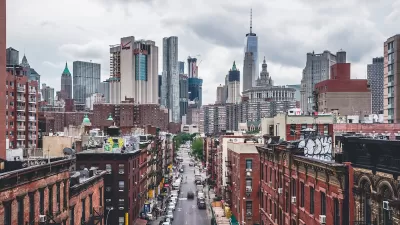Top-down and bottom-up planning are brushed aside in favor of the concept of a middle ground approach in the new book "Fast-Forward Urbanism: Rethinking Architecture's Engagement with the City". It could work, according to this review.
"Fast-Forward Urbanism is based on the proposition that change today occurs as a series of jump-cuts, with effects appearing as if out of nowhere, without any sense of how we got there. The result is a fragmented urbanism that is only understood in retrospect, when historical narratives help piece together the disparate events. The editors propose eight principles of the fast-forward urbanism that call for a "rejiggering" of existing behaviors, encouraging an accumulation of interventions as a means of catalyzing change, and demanding a renewed connection to the local political economy.
The manifesto builds upon the infrastructural outlook of landscape urbanism but articulates a concern for the limited progress that the field has made in urban settings. At a time of unstable economic horizons, the grand gestures of a modernist tradition fail to address specific conditions, while "everyday urbanism" rejects the top-down flow of capital and all-too-readily relinquishes the role of design in shaping cities and stimulating their recovery. Fast-Forward Urbanism seeks to fill in the city's weak spots not with unique projects but with systemic transformations that are neither top-down nor bottom-up and instead negotiate a middle-ground through applied research and the direct interaction of architecture with commercial and political spheres."
Such a prospect could take years or decades to prove itself, but the reviewer finds much hope in the prospect.
FULL STORY: Review> After the City

Alabama: Trump Terminates Settlements for Black Communities Harmed By Raw Sewage
Trump deemed the landmark civil rights agreement “illegal DEI and environmental justice policy.”

Planetizen Federal Action Tracker
A weekly monitor of how Trump’s orders and actions are impacting planners and planning in America.

The 120 Year Old Tiny Home Villages That Sheltered San Francisco’s Earthquake Refugees
More than a century ago, San Francisco mobilized to house thousands of residents displaced by the 1906 earthquake. Could their strategy offer a model for the present?

Ken Jennings Launches Transit Web Series
The Jeopardy champ wants you to ride public transit.

BLM To Rescind Public Lands Rule
The change will downgrade conservation, once again putting federal land at risk for mining and other extractive uses.

Indy Neighborhood Group Builds Temporary Multi-Use Path
Community members, aided in part by funding from the city, repurposed a vehicle lane to create a protected bike and pedestrian path for the summer season.
Urban Design for Planners 1: Software Tools
This six-course series explores essential urban design concepts using open source software and equips planners with the tools they need to participate fully in the urban design process.
Planning for Universal Design
Learn the tools for implementing Universal Design in planning regulations.
Clanton & Associates, Inc.
Jessamine County Fiscal Court
Institute for Housing and Urban Development Studies (IHS)
City of Grandview
Harvard GSD Executive Education
Toledo-Lucas County Plan Commissions
Salt Lake City
NYU Wagner Graduate School of Public Service





























